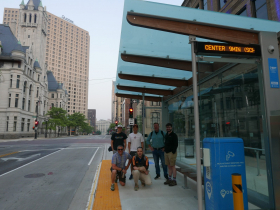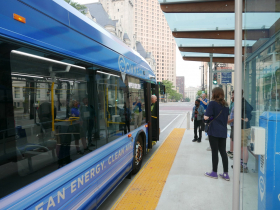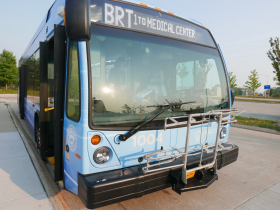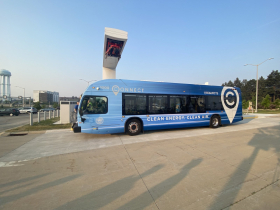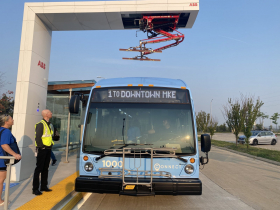Milwaukee’s First Bus Rapid Transit Line Is Open for Business
MCTS Connect 1 began rolling through early Sunday morning. Climb aboard to see how the first ride went.
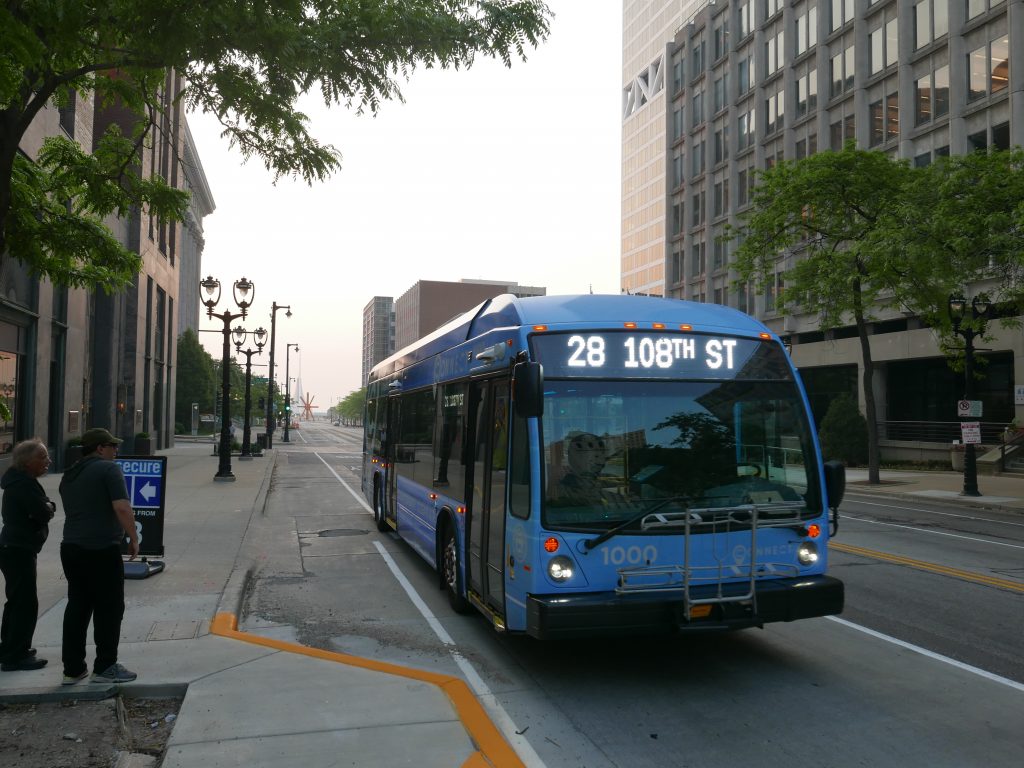
The battery electric bus that provided the first passenger service along the east-west bus rapid transit line, Connect 1. Photo by Graham Kilmer.
Just after 6 a.m. Sunday morning, bus number 1000 opened its doors for the first-ever bus service on the Milwaukee County Transit System‘s (MCTS) bus rapid transit line for a handful of passengers — most there to celebrate the inaugural trip.
Two passengers, Sam Deetz and Xiaotong Wang, made the trip from La Crosse to ride the new BRT service, called Connect 1. Deetz and Wang were joined by other transit enthusiasts who woke up early Sunday morning to ride the first-ever BRT line in Wisconsin history.n
The system promises faster travel times through a mix of dedicated lanes, traffic signal priority, off-bus ticketing and dedicated stations.
The bus, a new battery electric bus (BEB) built by Nova Bus, began its trip rolling west and stopping first at the BRT station on E. Wisconsin Ave. between N. Jackson and N. Buren Streets. The passengers that boarded included Deetz and Wang, several other transit enthusiasts and a few transit professionals — also enthusiasts — like Mike Zabel, a planner with project consultant HNTB; Jeff Sponcia, transportation manager with the Milwaukee County Department of Transportation; and Dave Steele, executive director of MobiliSE.
The BRT stations are an upgrade from the typical bus stop. They have glass shelters, elevated platforms, digital signs showing real-time bus arrivals and off-bus fare validators. Though, all rides on Connect 1 are free through the end of September thanks to sponsorship by Umo Mobility, the company that hosts the transit system’s new mobile apps and fare collection system.
Passengers on the new BEBs will notice that they seem more spacious than the typical clean-diesel bus operated by MCTS, with wider doors for entry and a different seating configuration that opens up the front area of the bus.
As bus number 1000 rolled along W. Wisconsin Ave. it began to pick up riders heading to work or elsewhere. Connect 1 takes over an important transit corridor in Milwaukee, running nine miles from Downtown to the Milwaukee Regional Medical Center in Wauwatosa.
One passenger, Daniel Beamon, was headed to work at Children’s Hospital of Wisconsin. As the bus neared the medical complex, he told Urban Milwaukee that he didn’t notice much difference in the service compared to the GoldLine, which was ended when Connect 1 took over most of the route Sunday morning. Beamon said he heard about the changing service from co-workers and that he had walked over to a BRT station near Froedtert to see what changes were in store and was impressed by the real-time signs.
Not everyone, though, was prepared for the changes like Beamon. During bus 1000’s westward trip to Wauwatosa, several passengers got on thinking the bus would provide service like Route 30 or the GoldLine, which previously ran through the corridor. Some standing at regular MCTS bus stops wore expressions of confusion as they watched the new BEB roll past them and stop further down the block at a new BRT station.
As the name of the service suggests, BRT is supposed to be rapid compared to regular routes. Part of this faster service is produced by making fewer stops. This also was a source of confusion for passengers expecting to take their typical trip to work, using the same stops they always have.
MCTS and MCDOT officials will be a near-constant presence on the buses for the first week. These transit employees are volunteering their time as Connect 1 “ambassadors”, helping new passengers understand the service: where their new stops or transfers will be, giving them new schedules, and explaining where what happened to the GoldLine. The MCTS Chief Financial Officer, Tim Hosch, started a shift as an ambassador shortly after 8 a.m. Sunday morning.
When the BEB arrived at its layover on Watertown Plank Rd. it pulled under the charging station, which the buses only need to use every three laps around the route. There was a minor technical hiccup and the new electric bus powered down and powered back up several times. MCTS officials offered to have passengers hop on a second BEB, bus number 1004, to head back east. But bus number 1000 was quickly back in service and rolled past number 1004 headed east again.
Scott Seeby, the bus operator on 1004, told Urban Milwaukee that the BEBs are “like an overgrown Tesla.”
“It’s a bus,” he said. “It drives like a bus. You operate the doors like a bus. The only difference is the propulsion system, the engine itself.” The BEBs don’t have the “lag” that the diesel buses have when getting up to speed. The operator feels more of a “direct push” as the bus accelerates, Seeby said, “And then as soon as you release the accelerator pedal, you decrease rapidly.”
Seeby said the operators have been training for months on the BEBs. He said the bus was handling well and that service seemed to be operating without problem.
One thing passengers will notice is that the BEBs are significantly quieter than a diesel bus. One rider on the Connect 1 Sunday morning commented that the loudest thing on the bus seemed to be the air conditioning. Another rider, Kali Ewert, told Urban Milwaukee” “I’d say it was surprisingly normal feeling given that it’s a completely new bus, but it was also a good experience — just wider and more open [in the front of the bus] and I love that.”
Steele, a transit advocate and regular rider, joined passengers on the maiden voyage of Connect 1. He called the new BEBs “beautiful” and noted, as a regular cyclist on Wisconsin Avenue, that drivers seemed to be respecting the bus-only lanes, which make up approximately 50% of the route. “I love the bus-only lanes,” he said, “which also double as bike lanes. It’s not like they’re honored 100% by drivers but for the most part I’ve only seen a handful of drivers disregard the lane thus far which is great.”
It didn’t take long for a cyclist to use the bike rack on the front of the BEB. In fact, Marquette University Law School researcher and Urban Milwaukee contributor John D. Johnson made local transit history as the first passenger to affix his bike to the front of an MCTS BEB.
As bus 1004 finished the first full circuit of BRT service along Connnet 1, Zabel, who has been working on the BRT project since it began in 2016, told Urban Milwaukee it was “surreal” to finally see the culmination of seven years of work by himself and the many others at MCTS and MCDOT that worked to bring the project together.
“It takes a village like it surely does,” said Zabel. “And it’s awesome.”
MCTS Managing Director Denise Wandke said in a statement “the entire organization” played a role in launching Connect 1. “It was a huge undertaking, and the quality of service shows the abilities of the team that we have here,” Wandke said. “I hope everyone gives the BRT a try!”
Photos
If you think stories like this are important, become a member of Urban Milwaukee and help support real, independent journalism. Plus you get some cool added benefits.
More about the East-West BRT Line
- Transportation: Off-Board Fare Collection Begins on Connect 1 - Graham Kilmer - Apr 16th, 2024
- Streetcar Begins Daily Service To The Couture, BRT Will Soon Follow - Jeramey Jannene - Apr 11th, 2024
- Transportation: Connect 1 Ridership Continues to Grow - Graham Kilmer - Nov 23rd, 2023
- Transportation: Battery Electric Buses Will Return This Fall - Graham Kilmer - Sep 8th, 2023
- Transportation: MCTS Pulling New Battery Electric Buses From the Road - Graham Kilmer - Aug 24th, 2023
- MKE County: Local Leaders Celebrate Launch of BRT Service - Graham Kilmer - Jun 5th, 2023
- Transportation: Milwaukee’s First Bus Rapid Transit Line Is Open for Business - Graham Kilmer - Jun 4th, 2023
- Transportation: New Bus Rapid Transit Line Launches Sunday, GoldLine Ends - Graham Kilmer - Jun 3rd, 2023
- Transportation: Federal Funds Creating Two New East-West BRT Stations - Graham Kilmer - May 19th, 2023
- Transportation: First 4 Months of BRT Rides Will be Free - Graham Kilmer - May 9th, 2023
Read more about East-West BRT Line here
MKE County
-
Fellow Judge Testifies in Dugan Case
 Dec 16th, 2025 by Graham Kilmer
Dec 16th, 2025 by Graham Kilmer
-
Key Questions in Dugan Trial Take Shape on First Day
 Dec 15th, 2025 by Graham Kilmer
Dec 15th, 2025 by Graham Kilmer
-
FTA Tells Milwaukee to Crack Down on Fare Evasion — Even Where Fares Don’t Exist
 Dec 12th, 2025 by Graham Kilmer
Dec 12th, 2025 by Graham Kilmer
Transportation
-
Congestion Pricing Cuts Air Pollution in New York City
 Dec 14th, 2025 by Jeff Wood
Dec 14th, 2025 by Jeff Wood
-
FTA Tells Milwaukee to Crack Down on Fare Evasion — Even Where Fares Don’t Exist
 Dec 12th, 2025 by Graham Kilmer
Dec 12th, 2025 by Graham Kilmer
-
Will GOGO’s Bus Service Ever Get Going?
 Dec 9th, 2025 by Jeramey Jannene
Dec 9th, 2025 by Jeramey Jannene


